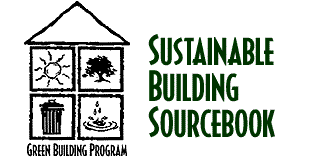
|

|
Choose a well-drained corner of the yard that is convenient to the kitchen and out of sight.
Clear the area to expose the soil.
Compost bins are easy to build. Remember:
You can use chicken wire, woven wire, or inexpensive fencing to build a bin. Try using wood stakes, wire, or chain snaps to support and fasten the bin. Discarded wood pallets can be put together with wire to make an inexpensive rectangular bin. A portable bin can be built of wood slats and wire mesh. Cinder blocks or brick can be used if gaps are left to allow air circulation.
Commercially prefabricated composters are available.
See the Solid Waste section of the Sourcebook for more information on composting.
Clippings can be left where they fall, recycling nutrients into the soil.
If clippings are collected, compost them with raked leaves and organic kitchen waste.
Never mow lawns too short. (Proper mowing heights can help lawns use less water. Grass cut too short is stressed and dries out quickly.)
Recommended Mowing Heights:
Other plants, such as non-native grasses, need additional nutrients for healthy growth.
Use recycled lawn clippings, compost, Dillo Dirt, or slow-release encapsulated nitrogen on lawns.
Old-fashioned methods such as installing a birdhouse for Purple Martins can help encourage natural insect control.
Chemical controls will destroy beneficial insects as well as harmful ones.
Organic pest control such as insecticidal soaps and manual methods such as pulling weeds or using sand barriers may do the job.
Beneficial insects such as ladybugs and beetles should be encouraged and can even be introduced into a landscape.
Overwatering and nighttime watering may actually cause some diseases such as brown patch on St. Augustine lawns.
Difficult problems such as fire ants can be tackled with boiling water treatments and growth regulators containing fenoxycarb.
Go to last guideline | Return to main Xeriscape page
return to Table of Contents
Sustainable Building Sourcebook web version copyright Sustainable Sources 1994-1999.